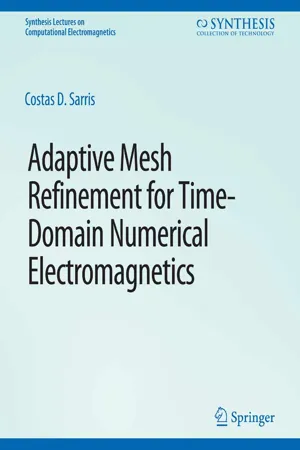
Adaptive Mesh Refinement in Time-Domain Numerical Electromagnetics
Costas D. Sarris
- English
- PDF
- Available on iOS & Android
Adaptive Mesh Refinement in Time-Domain Numerical Electromagnetics
Costas D. Sarris
About This Book
This monograph is a comprehensive presentation of state-of-the-art methodologies that can dramatically enhance the efficiency of the finite-difference time-domain (FDTD) technique, the most popular electromagnetic field solver of the time-domain form of Maxwell's equations. These methodologies are aimed at optimally tailoring the computational resources needed for the wideband simulation of microwave and optical structures to their geometry, as well as the nature of the field solutions they support. That is achieved by the development of robust "adaptive meshing" approaches, which amount to varying the total number of unknown field quantities in the course of the simulation to adapt to temporally or spatially localized field features. While mesh adaptation is an extremely desirable FDTD feature, known to reduce simulation times by orders of magnitude, it is not always robust. The specific techniques presented in this book are characterized by stability and robustness. Therefore, they are excellent computer analysis and design (CAD) tools. The book starts by introducing the FDTD technique, along with challenges related to its application to the analysis of real-life microwave and optical structures. It then proceeds to developing an adaptive mesh refinement method based on the use of multiresolution analysis and, more specifically, the Haar wavelet basis. Furthermore, a new method to embed a moving adaptive mesh in FDTD, the dynamically adaptive mesh refinement (AMR) FDTD technique, is introduced and explained in detail. To highlight the properties of the theoretical tools developed in the text, a number of applications are presented, including: Microwave integrated circuits (microstrip filters, couplers, spiral inductors, cavities). Optical power splitters, Y-junctions, and couplers Optical ring resonators Nonlinear optical waveguides. Building on first principles of time-domain electromagnetic simulations, this book presents advanced concepts and cutting-edge modeling techniques in an intuitive way for programmers, engineers, and graduate students. It is designed to provide a solid reference for highly efficient time-domain solvers, employed in a wide range of exciting applications in microwave/millimeter-wave and optical engineering.
Frequently asked questions
Information
Table of contents
- Cover
- Copyright Page
- Title Page
- Contents
- Acknowledgments
- List of Tables
- List of Figures
- Introduction
- ANumerical Interface Between FDTD and HaarMRTD: Formulation and Applications
- Efficient Implementation of Adaptive Mesh Refinement in the Haar Wavelet-basedMRTD Technique
- TheDynamically Adaptive Mesh Refinement (AMR)-FDTD Technique: Theory
- Dynamically Adaptive Mesh Refinement in FDTD: Microwave Circuit Applications
- Dynamically Adaptive Mesh Refinement in FDTD: Optical Applications and Error Estimates
- Bibliography
- Author Biography